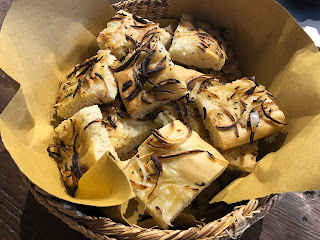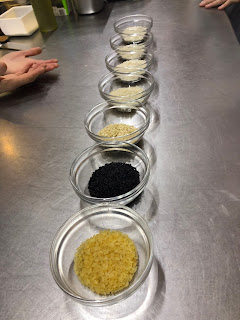Understanding Umbrian Cuisine
Umbria is located in central Italy, right between Lazio and Marche. This means that there is no coast, but there are rivers, which is where they get their fish. The region is very hilly, with only a few flat lands right in the middle, therefore their economy is not really affected. The Etruscan people populated this region, after conquering the Umbri people. After Umbria, the Etruscans traveled to Naples along the coast. With such deep Etscan roots, it is important to note their love for food. As we say in Tuscany, the Etruscans loved food and the wealthy ate twice a day. They had huge banquets with a lot of food and women were even invited. This is important to the culture of Umbria as this is what their society was mainly built upon.
Here is some more research I did on the history of Umbria:
Like we learned today, there were 2 major tribes in Umbria: the Etruscans and the Umbri. The Umbri had settled in the region first, dating back to 1,000 BC, then the Etruscans came. The Tevere River divided the region into two, east and west, with the Umbri on the east and the Etruscans on the west. Around 300 BC, everything changed in Umbria when the Romans came to the villages. In just 5 short years, all of Umbria was conquered by the Romans. The Romans often get a negative vibe for what they did, but they also established a public works system that can still be seen today.
After the Romans, there were invasions by the Sarcens, Goths, Lombards, Byzantines, and the Barbarians. All of these invasions led to an economic and cultural decline for the entire region. People began to starve and disease spread rapidly. The Umbrians began retreating to fortified medieval hills towns to survive.
Moving into the cuisine of Umbria, there is a lot of tradition within this region. Here are a few dishes that date far back into their history:
- Palomba alla Ghiotta: Squab roasted on a spit that is gutted after cooking. The inners are used to make a sauce for the meat.
- Tegamaccio: This is the traditional way of cooking fish in the region. It is a stewed fish served in a terracotta pot.
- Stringozzi: No eggs are used in the making of this pasta, but it is long and flat, similar to tagliatelle. It is usually eaten with black truffle sauce or can be boiled and dressed in walnuts, breadcrumbs, sugar, cinnamon, and Mistra for a sweeter pasta dish.
There are a few very interesting Slow Food Procedure Products in Umbria also. Here are just a few:
- Sedano Nero a Trevi: This is a celery that must be grown in a specific way. If it is not covered, it will become stringy and a very dark color. It is often planted on the Friday before Easter because Catholics believe if you plant things on that day, they will grow faster.
- Roveja di Civita di Cascia: These are wild peas that produce a very small yield. They can be different colors, all in the same pod. They are full of protein and grown along the border of Marche.
Today I made Schiacciata con le cipolle, which is similar to focaccia, but a starter is used. I really liked this recipe, but maybe next time I would add more salt as I thought it did not have much flavor. anyway, I wanted to share the recipe with you so here it is!
For the Starter -
150 grams High Gluten Flour
80 grams Water
25 grams Fresh Yeast
A pinch of salt
For the Dough -
(All of the starter goes in)
350 grams Flour
200 grams Water
5 grams salt
20 grams oil
40 grams rendered lard
For topping -
2 large onions
Sage
Method:
1. Melt the yeast in warm water with a pinch of salt.
2. Add flour and mix together.
3. Let the starter rest for about 1 hour in a covered bowl.
4. In a mixer, mix the starter, flour, water, and oil.
5. When it comes together, add the salt and lard.
6. Let mix/knead for 20 minutes.
7. Allow the dough to rest for about 1 hour.
8. Julienne the onions and put salt on them to dry them out a bit.
9. Divide the dough into 2 and place in 2 baking pans that are greased generously with oil.
10. Top the dough with the sage leaves, onions, and more oil.
11. Bake at 200 C for about 20 minutes.
Here is some more research I did on the history of Umbria:
Like we learned today, there were 2 major tribes in Umbria: the Etruscans and the Umbri. The Umbri had settled in the region first, dating back to 1,000 BC, then the Etruscans came. The Tevere River divided the region into two, east and west, with the Umbri on the east and the Etruscans on the west. Around 300 BC, everything changed in Umbria when the Romans came to the villages. In just 5 short years, all of Umbria was conquered by the Romans. The Romans often get a negative vibe for what they did, but they also established a public works system that can still be seen today.
After the Romans, there were invasions by the Sarcens, Goths, Lombards, Byzantines, and the Barbarians. All of these invasions led to an economic and cultural decline for the entire region. People began to starve and disease spread rapidly. The Umbrians began retreating to fortified medieval hills towns to survive.
Moving into the cuisine of Umbria, there is a lot of tradition within this region. Here are a few dishes that date far back into their history:
- Palomba alla Ghiotta: Squab roasted on a spit that is gutted after cooking. The inners are used to make a sauce for the meat.
- Tegamaccio: This is the traditional way of cooking fish in the region. It is a stewed fish served in a terracotta pot.
- Stringozzi: No eggs are used in the making of this pasta, but it is long and flat, similar to tagliatelle. It is usually eaten with black truffle sauce or can be boiled and dressed in walnuts, breadcrumbs, sugar, cinnamon, and Mistra for a sweeter pasta dish.
There are a few very interesting Slow Food Procedure Products in Umbria also. Here are just a few:
- Sedano Nero a Trevi: This is a celery that must be grown in a specific way. If it is not covered, it will become stringy and a very dark color. It is often planted on the Friday before Easter because Catholics believe if you plant things on that day, they will grow faster.
- Roveja di Civita di Cascia: These are wild peas that produce a very small yield. They can be different colors, all in the same pod. They are full of protein and grown along the border of Marche.
Today I made Schiacciata con le cipolle, which is similar to focaccia, but a starter is used. I really liked this recipe, but maybe next time I would add more salt as I thought it did not have much flavor. anyway, I wanted to share the recipe with you so here it is!
Recipe Title: Sciacciata con le cipolle
Ingredients:For the Starter -
150 grams High Gluten Flour
80 grams Water
25 grams Fresh Yeast
A pinch of salt
For the Dough -
(All of the starter goes in)
350 grams Flour
200 grams Water
5 grams salt
20 grams oil
40 grams rendered lard
For topping -
2 large onions
Sage
Method:
1. Melt the yeast in warm water with a pinch of salt.
2. Add flour and mix together.
3. Let the starter rest for about 1 hour in a covered bowl.
4. In a mixer, mix the starter, flour, water, and oil.
5. When it comes together, add the salt and lard.
6. Let mix/knead for 20 minutes.
7. Allow the dough to rest for about 1 hour.
8. Julienne the onions and put salt on them to dry them out a bit.
9. Divide the dough into 2 and place in 2 baking pans that are greased generously with oil.
10. Top the dough with the sage leaves, onions, and more oil.
11. Bake at 200 C for about 20 minutes.
With love,
- Baylee Mello




Comments
Post a Comment